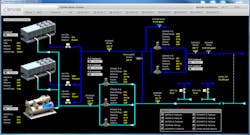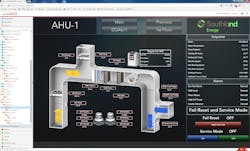Aging Building-Management Systems: Dilemma or Opportunity?
Today, many building owners and managers find themselves left wanting by an aging building-management system (BMS). This may be because:
- The BMS manufacturer no longer is in business.
- The BMS is proprietary, which prevents the owner from competitively bidding expansions, tenant improvements, and additions.
- The BMS is not expandable and is too expensive to maintain.
- The BMS is not intuitive and, thus, is difficult to operate.
- The BMS is not adaptable to new technologies (e.g., web enablement, analytics).
- The BMS cannot perform sophisticated energy-control programs.
- The BMS cannot be integrated with other systems (e.g., security, metering, closed-circuit television, access, energy, HVAC).
Any of these factors can challenge a building owner’s or manager’s ability to keep budgets in check while maintaining comfort, providing good indoor-air quality, and maximizing HVAC energy efficiency. Additionally, they can frustrate and lower morale among a facility’s staff.
This article will discuss two options available to building owners and managers dealing with a dated or obsolete BMS: (1) integrate into a new head-end platform (graphical user interface [GUI]) and (2) replace.
Integration
Replacing a BMS can be expensive. A lower-first-cost option is upgrading to a new head-end platform without replacing controllers. Before deciding to integrate, a building owner or manager should conduct extensive research and testing because of:
• Communication speed. A new head-end will communicate only as fast as the slowest part of the existing BMS. For example, if a BMS communicates at 19.2K baud, then the fastest a new head-end will communicate is 19.2K baud.
• Hidden costs. The cost of integration can be high, as it is not simply a matter of “plug and play.” Integration might require a third-party driver on a special communication device to “bridge” the communication of the existing BMS with that of a new head-end. Thus, for successful integration, a building owner or manager must be assured the BMS provider thoroughly understands the programming of both the existing BMS and the new head-end. The building owner or manager should consult customers who have had similar work performed to understand general operational issues and gauge the customers’ level of satisfaction post-integration.
• Multiple programming tools. If the make of a new head-end and the make of an existing BMS are not compatible, multiple programming tools may be required for proper access to the systems. This can create additional work for a building’s staff.
Replacement
Replacement of an entire system with a new BMS offers several advantages, including improvement of overall operation, increase in communication speed, a new warranty, greater intuitiveness, and adaptability to the latest technologies.
Proper replacement of a BMS requires the following of a few steps: create a list of needs, establish a budget, and determine funding.
Create a list of needs. The building owner or manager should meet with his or her staff to determine what is needed from the new system. Immediate needs may be as complex as web enablement to a fully BACnet-based system and ensuring the ability to seamlessly connect to the building’s analytics program or as simple as employing a single software tool for BMS functions. No matter the level of complexity, this conversation between building owner/manager and staff will ensure everyone is on the same page.
Establish a budget. To properly assess the situation and determine next steps, the overall cost of the project should be determined. Considerations include:
- Selecting local and reputable BMS companies. Determine the reputability of BMS companies by speaking directly with their customers. Gauge the BMS companies’ ability to provide local training, their relationship with the manufacturer, and their track record in performing similar installations.
- Hiring a consultant. Look for a consultant who specializes in BMS and ask for a cost analysis for replacing the existing system.
- Research. Engage industry peers who have implemented similar projects.
Phased installation. Once the budget is set, the building owner or manager needs to determine if the BMS can be replaced at once or if a staged approach is required.
To develop a phased BMS-replacement plan, building owners and managers first must determine the number of phases. The first phase should focus on the most problematic areas, followed by whatever needed work can be accomplished with the remainder of the designated budget.
After identifying the areas of the building in need of attention during the project’s first phase, the building owner or manager should develop a scope of work to elicit accurate and complete pricing from BMS companies.
Example: Scope of work for phased project. If the Phase 1 area of a building consists of four air handlers and 70 variable-air-volume (VAV) zones, the required scope of work will be to replace the four air-handling-unit (AHU) controllers and 70 VAV controllers with new BACnet controllers, including end devices (e.g., temperature sensors, damper actuators) that may be required. This step is necessary because the devices must communicate on a new network back to a new head-end workstation. The new workstation will have a full graphical interface and reporting feature to communicate to the new controllers. Thus, pricing for Phase 1 could reflect:
- Four new AHU controllers: $50,000.
- 70 new VAV controllers: $125,000.
- New workstation GUI: $25,000.
The total for Phase 1 work, then, will be $200,000.
Building owners and managers will need to take the same approach for all subsequent phases of work.
Considerations for the scope of work. During the time needed to complete the BMS retrofit, which in the case of our example is three years, the facilities staff will need to operate two workstations—one for the new BMS and one for the existing BMS—simultaneously. The building owner or manager will need to determine the best course of action for this.
As existing controllers are “harvested,” they can be set aside to be used for future repairs of the existing BMS during the retrofit. (Note: The BMS company will need to include the harvesting of existing controllers in its scope of work.)
New AHU and central-plant controllers should communicate via BACnet over Ethernet to take advantage of the high speed of Ethernet. Either a new Ethernet network can be installed or the information-technology (IT) department can be asked to provide Ethernet drops to the locations of the new controllers so the controllers can be networked. In the case of Ethernet drops to controllers, the new BMS will communicate on the owner’s network through a virtual network the IT department will need to implement.
Summary
Replacing a dated or obsolete BMS is a sound business decision. Major benefits include a new system with a manufacturer’s warranty and a system that can operate with today’s advanced technologies. Additionally, there is a good chance the facilities staff will be happier and more productive with a new BMS.
Tim Potter is vice president and Southwest branch manager for Envise, a national building-systems integrator. He can be contacted at [email protected].
About the Author
TIM POTTER
Vice President and Southwest Branch Manager
Tim Potter is vice president and Southwest branch manager for Envise, a national building-systems integrator. He can be contacted at [email protected].



